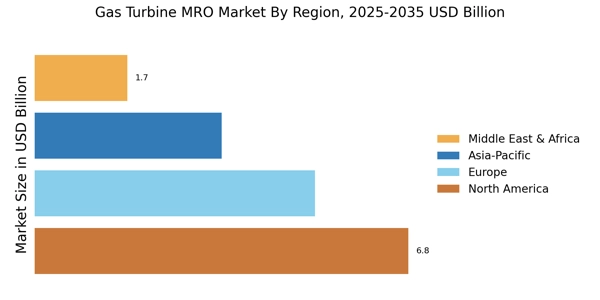Aging Infrastructure
Aging infrastructure presents a significant challenge and opportunity within the Gas Turbine MRO Market. Many existing gas turbines are approaching the end of their operational lifespan, necessitating extensive maintenance and refurbishment. This trend is particularly evident in regions where older power plants are still in operation. The need for upgrades and retrofitting to meet modern efficiency standards drives demand for MRO services. Data indicates that a substantial portion of gas turbines in operation are over 20 years old, which may require specialized MRO solutions to extend their operational life. As such, the Gas Turbine MRO Market is poised to benefit from the increasing need to address aging assets while ensuring compliance with evolving environmental regulations.
Increasing Demand for Energy
The rising demand for energy across various sectors is a primary driver for the Gas Turbine MRO Market. As economies expand, the need for reliable and efficient power generation becomes paramount. Gas turbines are favored for their ability to provide quick ramp-up times and operational flexibility. According to recent data, the energy sector is projected to grow at a compound annual growth rate of approximately 4.5% over the next decade. This growth necessitates regular maintenance, repair, and overhaul services to ensure optimal performance and compliance with regulatory standards. Consequently, the Gas Turbine MRO Market is likely to experience heightened activity as operators seek to enhance the reliability and efficiency of their gas turbine fleets.
Technological Innovations in MRO Services
Technological innovations are reshaping the landscape of the Gas Turbine MRO Market. Advancements in predictive maintenance, data analytics, and remote monitoring are enhancing the efficiency and effectiveness of MRO services. These technologies enable operators to anticipate maintenance needs, thereby reducing downtime and optimizing operational performance. The integration of artificial intelligence and machine learning into MRO processes is also gaining traction, allowing for more precise diagnostics and tailored maintenance strategies. As these technologies continue to evolve, they are expected to drive significant growth in the Gas Turbine MRO Market, as operators seek to leverage these innovations to improve reliability and reduce operational costs.
Regulatory Compliance and Environmental Standards
The Gas Turbine MRO Market is significantly influenced by stringent regulatory compliance and environmental standards. Governments worldwide are implementing more rigorous emissions regulations, compelling operators to invest in MRO services that enhance the environmental performance of their gas turbines. Compliance with these regulations often requires upgrades and modifications, which can only be achieved through specialized maintenance and repair services. The market is witnessing a shift towards cleaner technologies, with a focus on reducing greenhouse gas emissions. As a result, the Gas Turbine MRO Market is likely to see increased demand for services that not only maintain operational efficiency but also ensure adherence to environmental standards, thereby driving growth.
Growing Investment in Renewable Energy Integration
The increasing investment in renewable energy sources is influencing the Gas Turbine MRO Market. As more countries aim to diversify their energy portfolios, gas turbines are often used in conjunction with renewable sources to provide backup power and grid stability. This hybrid approach necessitates ongoing maintenance and optimization of gas turbine systems to ensure they can effectively complement renewable energy generation. Data suggests that the integration of gas turbines with renewable energy systems is expected to rise, leading to a corresponding increase in demand for MRO services. Consequently, the Gas Turbine MRO Market is likely to benefit from this trend as operators seek to enhance the performance and reliability of their gas turbine assets.


















Leave a Comment